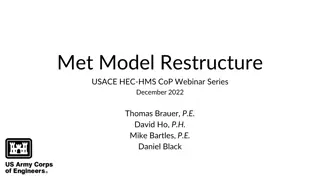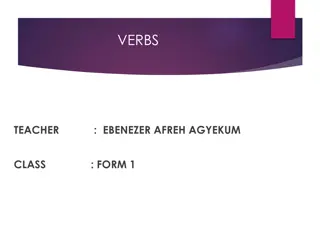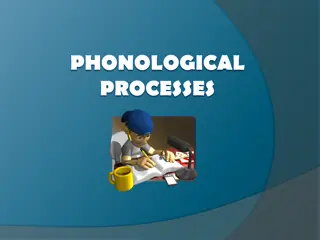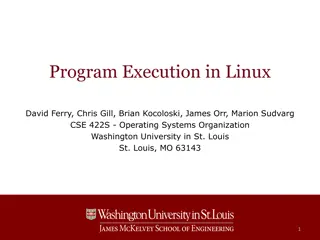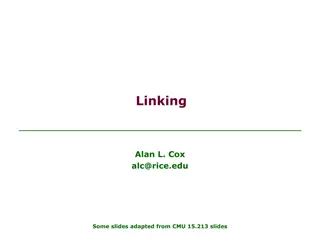
Introduction to Computer Organization Concepts
Explore the fundamentals of computer organization through topics like static linking, linker functions, symbol resolution, and more. Understand why linkers are essential in programming and learn about the efficiency and modularity benefits they offer to developers. Dive into the process of linking programs and symbol resolution steps to enhance your understanding of computer systems.
Download Presentation

Please find below an Image/Link to download the presentation.
The content on the website is provided AS IS for your information and personal use only. It may not be sold, licensed, or shared on other websites without obtaining consent from the author. If you encounter any issues during the download, it is possible that the publisher has removed the file from their server.
You are allowed to download the files provided on this website for personal or commercial use, subject to the condition that they are used lawfully. All files are the property of their respective owners.
The content on the website is provided AS IS for your information and personal use only. It may not be sold, licensed, or shared on other websites without obtaining consent from the author.
E N D
Presentation Transcript
Carnegie Mellon Linking COMP 222: Introduction to Computer Organization Instructor: Alan L. Cox 1 Bryant and O Hallaron, Computer Systems: A Programmer s Perspective, Third Edition
Example C Program int sum(int *a, int n); int sum(int *a, int n) { int i, s = 0; int array[2] = {1, 2}; int main(void) { int val = sum(array, 2); return val; } for (i = 0; i < n; i++) { s += a[i]; } return s; } main.c sum.c 2 Bryant and O Hallaron, Computer Systems: A Programmer s Perspective, Third Edition
Static Linking Programs are translated and linked using a compiler driver: CLEAR> gcc O -g -o prog main.c sum.c CLEAR> ./prog main.c sum.c Source files Translators (cpp, cc1, as) Translators (cpp, cc1, as) Separately compiled relocatable object files main.o sum.o Linker (ld) Fully linked executable object file (contains code and data for all functions defined in main.c and sum.c) prog 3 Bryant and O Hallaron, Computer Systems: A Programmer s Perspective, Third Edition
Why Linkers? Reason 1: Modularity Program can be written as a collection of smaller source files, rather than one monolithic mass. Can build libraries of common functions (more on this later) e.g., Math library, standard C library 4 Bryant and O Hallaron, Computer Systems: A Programmer s Perspective, Third Edition
Why Linkers? (cont) Reason 2: Efficiency Time: Separate compilation Change one source file, compile, and then relink. No need to recompile other source files. Space: Libraries Common functions can be aggregated into a single file... Yet executable files and running memory images contain only code for the functions they actually use. 5 Bryant and O Hallaron, Computer Systems: A Programmer s Perspective, Third Edition
What Do Linkers Do? Step 1: Symbol resolution Programs define and reference symbols (global variables and functions): void swap() { } /* define symbol swap */ swap(); /* reference symbol swap */ int *xp = &x; /* define symbol xp, reference x */ Symbol definitions are stored in object file (by assembler) in symbol table. Symbol table is an array of structs Each entry includes name, size, and location of symbol. During symbol resolution step, the linker associates each symbol reference with exactly one symbol definition. 6 Bryant and O Hallaron, Computer Systems: A Programmer s Perspective, Third Edition
What Do Linkers Do? (cont) Step 2: Relocation Merges separate code and data sections into single sections Relocates symbols from their relative locations in the .o files to their final absolute memory locations in the executable. Updates all references to these symbols to reflect their new positions. Let s look at these two steps in more detail . 7 Bryant and O Hallaron, Computer Systems: A Programmer s Perspective, Third Edition
Three Kinds of Object Files (Modules) Relocatable object file (.o file) Contains code and data in a form that can be combined with other relocatable object files to form executable object file. Each .o file is produced from exactly one source (.c) file Executable object file (a.out file) Contains code and data in a form that can be copied directly into memory and then executed. Shared object file (.so file) Special type of relocatable object file that can be loaded into memory and linked dynamically, at either load time or run-time. Called Dynamic Link Libraries (DLLs) by Windows 8 Bryant and O Hallaron, Computer Systems: A Programmer s Perspective, Third Edition
Executable and Linkable Format (ELF) Standard binary format for object files One unified format for Relocatable object files (.o), Executable object files (a.out) Shared object files (.so) Generic name: ELF binaries 9 Bryant and O Hallaron, Computer Systems: A Programmer s Perspective, Third Edition
ELF Object File Format Elf header Word size, byte ordering, file type (.o, exec, .so), machine type, etc. 0 ELF header Segment header table Page size, virtual addresses memory segments (sections), segment sizes. Segment header table (required for executables) .text section .text section Code .rodata section .data section .rodata section Read only data: jump tables, ... .bss section .symtab section .data section Initialized global variables .rel.txt section .rel.data section .bss section Uninitialized global variables Block Started by Symbol Better Save Space .debug section Section header table Bryant and O Hallaron, Computer Systems: A Programmer s Perspective, Third Edition Has section header but occupies no space 10
ELF Object File Format (cont.) .symtab section Symbol table Procedure and static variable names Section names and locations 0 ELF header Segment header table (required for executables) .rel.text section Relocation info for .textsection Addresses of instructions that will need to be modified in the executable Instructions for modifying. .text section .rodata section .data section .bss section .rel.data section Relocation info for .datasection Addresses of pointer data that will need to be modified in the merged executable .symtab section .rel.txt section .rel.data section .debug section Info for symbolic debugging (gcc -g) .debug section Section header table Section header table Offsets and sizes of each section 11 Bryant and O Hallaron, Computer Systems: A Programmer s Perspective, Third Edition
Linker Symbols Global symbols Symbols defined by module m that can be referenced by other modules. E.g.: non-static C functions and non-static global variables. External symbols Global symbols that are referenced by module m but defined by some other module. Local symbols Symbols that are defined and referenced exclusively by module m. E.g.: C functions and global variables defined with the staticattribute. Local linker symbols are not local program variables 12 Bryant and O Hallaron, Computer Systems: A Programmer s Perspective, Third Edition
Step 1: Symbol Resolution Referencing a global that s defined here int sum(int *a, int n); int sum(int *a, int n) { int i, s = 0; int array[2] = {1, 2}; int main(void) { int val = sum(array, 2); return val; } for (i = 0; i < n; i++) { s += a[i]; } return s; main.c sum.c } Defining a global Referencing a global Linker knows nothing of i or s Linker knows nothing of val that s defined here 13 Bryant and O Hallaron, Computer Systems: A Programmer s Perspective, Third Edition
Local Symbols Local non-static C variables vs. local static C variables local non-static C variables: stored on the stack local static C variables: stored in either .bss or .data int f(void) { static int x = 3; return x; } Compiler allocates space in .data for each definition of x and stores its initial value in that space int g(void) { static int x = 5; return x; } Creates local symbols in the symbol table with unique names, e.g., x.1 and x.2. 14 Bryant and O Hallaron, Computer Systems: A Programmer s Perspective, Third Edition
How Linker Resolves Duplicate Symbol Definitions Program symbols are either strong or weak Strong: procedures and initialized globals Weak: uninitialized globals p1.c p2.c int foo=5; int foo; weak strong p1() { } p2() { } strong strong 15 Bryant and O Hallaron, Computer Systems: A Programmer s Perspective, Third Edition
Linkers Symbol Rules Rule 1: Multiple strong symbols are not allowed Each item can be defined only once Otherwise: Linker error Rule 2: Given a strong symbol and multiple weak symbols, choose the strong symbol References to the weak symbol resolve to the strong symbol Rule 3: If there are multiple weak symbols, pick an arbitrary one Can override this with gcc fno-common Newer versions of gcc include fno-common by default 16 Bryant and O Hallaron, Computer Systems: A Programmer s Perspective, Third Edition
Linker Puzzles int x; p1() {} Link time error: two strong symbols (p1) p1() {} int x; p1() {} int x; p2() {} References to x will refer to the same uninitialized int. Is this what you really want? int x; int y; p1() {} double x; p2() {} Writes to x in p2 might overwrite y! Evil! int x=7; int y=5; p1() {} double x; p2() {} Writes to x in p2 will overwrite y! Nasty! References to x will refer to the same initialized variable. int x=7; p1() {} int x; p2() {} Nightmare scenario: two identical weak structs, compiled by different compilers with different alignment rules. 17 Bryant and O Hallaron, Computer Systems: A Programmer s Perspective, Third Edition
Global Variables Avoid if you can Otherwise Use staticif you can Initialize if you define a global variable Use extern if you reference an external global variable Recall the craps program from the first week of class 18 Bryant and O Hallaron, Computer Systems: A Programmer s Perspective, Third Edition
Carnegie Mellon Example: random.h /* * Declares the interface to a pseudo-random number generator * that returns an integer between 0 and 32767. */ // Used to compute the next pseudo-random number. extern unsigned long next; // Returns a pseudo-random number between 0 and 32767. int generate(void); 19 Bryant and O Hallaron, Computer Systems: A Programmer s Perspective, Third Edition
Carnegie Mellon Example: random.c /* * Implements a pseudo-random number generator * that returns an integer between 0 and 32767. */ #include "random.h" /* * The first computation within the function generate * can overflow, so this variable must be unsigned. */ unsigned long next; int generate(void) { next = (next * 1103515245) + 12345; return ((unsigned int)(next / 65536) % 32768); } 20 Bryant and O Hallaron, Computer Systems: A Programmer s Perspective, Third Edition
Carnegie Mellon Example: craps.c /* * This program plays the game of craps. */ #include <stdbool.h> #include <stdio.h> #include <time.h> #include "random.h" The file continues ... 21 Bryant and O Hallaron, Computer Systems: A Programmer s Perspective, Third Edition
Carnegie Mellon Example: craps.c (cont.) int main(void) { // Seed the random number generator to a new value every second. next = (unsigned long)time(NULL); // Perform the first roll of the two dice. int counter = 1; int first_roll = roll_dice(2); printf("Result of roll #%d: %d\n", counter, first_roll); // Compute the result of the first roll. bool winner = false; bool loser = false; if (first_roll == 7 || first_roll == 11) winner = true; else if (first_roll == 2 || first_roll == 3 || first_roll == 12) loser = true; 22 Bryant and O Hallaron, Computer Systems: A Programmer s Perspective, Third Edition
Step 2: Relocation Relocatable Object Files Executable Object File .text .data 0 System code Headers System data System code main() .text main.o swap() .text main() .data More system code int array[2]={1,2} System data .data sum.o int array[2]={1,2} .text sum() .symtab .debug 23 Bryant and O Hallaron, Computer Systems: A Programmer s Perspective, Third Edition
Relocation Entries int array[2] = {1, 2}; int main() { int val = sum(array, 2); return val; } main.c 0000000000000000 <main>: 0: 48 83 ec 08 sub $0x8,%rsp 4: be 02 00 00 00 mov $0x2,%esi 9: bf 00 00 00 00 mov $0x0,%edi # %edi = &array a: R_X86_64_32 array # Relocation entry e: e8 00 00 00 00 callq 13 <main+0x13> # sum() f: R_X86_64_PC32 sum-0x4 # Relocation entry 13: 48 83 c4 08 add $0x8,%rsp 17: c3 retq main.o Source: objdump r d main.o 24 Bryant and O Hallaron, Computer Systems: A Programmer s Perspective, Third Edition
Relocated .text section 00000000004004d0 <main>: 4004d0: 48 83 ec 08 sub $0x8,%rsp 4004d4: be 02 00 00 00 mov $0x2,%esi 4004d9: bf 18 10 60 00 mov $0x601018,%edi # %edi = &array 4004de: e8 05 00 00 00 callq 4004e8 <sum> # sum() 4004e3: 48 83 c4 08 add $0x8,%rsp 4004e7: c3 retq 00000000004004e8 <sum>: 4004e8: b8 00 00 00 00 mov $0x0,%eax 4004ed: ba 00 00 00 00 mov $0x0,%edx 4004f2: eb 09 jmp 4004f4: 48 63 ca movslq %edx,%rcx 4004f7: 03 04 8f add (%rdi,%rcx,4),%eax 4004fa: 83 c2 01 add $0x1,%edx 4004fd: 39 f2 cmp 4004ff: 7c f3 jl 400501: c3 retq 4004fd <sum+0x15> %esi,%edx 4004f4 <sum+0xc> Using PC-relative addressing for sum(): 0x4004e8 = 0x4004e3 + 0x5 Source: objdump -dx prog 25 Bryant and O Hallaron, Computer Systems: A Programmer s Perspective, Third Edition
Loading Executable Object Files Memory invisible to user code Executable Object File Kernel virtual memory 0 ELF header User stack (created at runtime) Program header table (required for executables) %rsp (stack pointer) .init section .text section Memory-mapped region for shared libraries .rodata section .data section .bss section brk Run-time heap (created by malloc) .symtab .debug Loaded from the executable file Read/write data segment (.data, .bss) .line .strtab Read-only code segment (.init, .text, .rodata) Section header table (required for relocatables) 0x400000 Unused 0 26 Bryant and O Hallaron, Computer Systems: A Programmer s Perspective, Third Edition
Packaging Commonly Used Functions How to package functions commonly used by programmers? Math, I/O, memory management, string manipulation, etc. Awkward, given the linker framework so far: Option 1: Put all functions into a single source file Programmers link big object file into their programs Space and time inefficient Option 2: Put each function in a separate source file Programmers explicitly link appropriate binaries into their programs More efficient, but burdensome on the programmer 27 Bryant and O Hallaron, Computer Systems: A Programmer s Perspective, Third Edition
Old-fashioned Solution: Static Libraries Static libraries (.a archive files) Concatenate related relocatable object files into a single file with an index (called an archive). Enhance linker so that it tries to resolve unresolved external references by looking for the symbols in one or more archives. If an archive member file resolves reference, link it into the executable. 28 Bryant and O Hallaron, Computer Systems: A Programmer s Perspective, Third Edition
Creating Static Libraries atoi.c printf.c random.c ... Translator Translator Translator atoi.o printf.o random.o unix> ar rs libc.a \ atoi.o printf.o random.o Archiver (ar) libc.a C standard library Archiver allows incremental updates Recompile function that changes and replace .o file in archive. 29 Bryant and O Hallaron, Computer Systems: A Programmer s Perspective, Third Edition
Commonly Used Libraries on CLEAR libc.a (the C standard library) 6.7 MB archive of 2058 object files. I/O, memory allocation, signal handling, string handling, data and time, random numbers, integer math libm.a (the C math library) 2.7 MB archive of 749 object files. floating point math (sin, cos, tan, log, exp, sqrt, ) % ar t libc.a | sort fork.o fprintf.o fpu_control.o fputc.o freopen.o fscanf.o fseek.o fstab.o % ar t libm.a | sort e_acos.o e_acosf.o e_acosh.o e_acoshf.o e_acoshl.o e_acosl.o e_asin.o e_asinf.o e_asinl.o 30 Bryant and O Hallaron, Computer Systems: A Programmer s Perspective, Third Edition
Linking with Static Libraries libvector.a void addvec(int *x, int *y, int *z, int n) { int i; #include <stdio.h> #include "vector.h" int x[2] = {1, 2}; int y[2] = {3, 4}; int z[2]; for (i = 0; i < n; i++) z[i] = x[i] + y[i]; } addvec.c int main() { addvec(x, y, z, 2); printf("z = [%d %d]\n , z[0], z[1]); return 0; } void multvec(int *x, int *y, int *z, int n) { int i; for (i = 0; i < n; i++) z[i] = x[i] * y[i]; main2.c } multvec.c 31 Bryant and O Hallaron, Computer Systems: A Programmer s Perspective, Third Edition
Linking with Static Libraries multvec.o addvec.o main2.c vector.h Archiver (ar) Translators (cpp, cc1, as) Static libraries libvector.a libc.a printf.o and any other modules called by printf.o Relocatable object files main2.o addvec.o Linker (ld) Fully linked executable object file prog2c c for compile-time 32 Bryant and O Hallaron, Computer Systems: A Programmer s Perspective, Third Edition
Using Static Libraries Linker s algorithm for resolving external references: Scan .o files and .a files in the command line order. During the scan, keep a list of the current unresolved references. As each new .o or .a file, obj, is encountered, try to resolve each unresolved reference in the list against the symbols defined in obj. If any entries in the unresolved list at end of scan, then error. Problem: Command line order matters! Moral: put libraries at the end of the command line. CLEAR> gcc -L. libtest.o -lmine CLEAR> gcc -L. -lmine libtest.o libtest.o: In function `main': libtest.o(.text+0x4): undefined reference to `libfun' 33 Bryant and O Hallaron, Computer Systems: A Programmer s Perspective, Third Edition
Modern Solution: Shared Libraries Static libraries have the following disadvantages: Duplication in the stored executables (every function needs libc) Duplication in the running executables Minor bug fixes of system libraries require each application to explicitly relink Modern solution: Shared Libraries Object files that contain code and data that are loaded and linked into an application dynamically, at either load-time or run-time Also called: dynamic link libraries, DLLs, .so files 34 Bryant and O Hallaron, Computer Systems: A Programmer s Perspective, Third Edition
Shared Libraries (cont.) Dynamic linking can occur when executable is first loaded and run (load-time linking). Common case for Linux, handled automatically by the dynamic linker (ld- linux.so). Standard C library (libc.so) usually dynamically linked. Dynamic linking can also occur after program has begun (run-time linking). In Linux, this is done by calls to the dlopen() interface. Distributing software. High-performance servers that can't be restarted. Runtime library interpositioning. Shared library routines can be shared by multiple processes. More on this when you learn about virtual memory in COMP 321 35 Bryant and O Hallaron, Computer Systems: A Programmer s Perspective, Third Edition
Dynamic Linking at Load-time main2.c vector.h unix> gcc -shared -o libvector.so \ addvec.c multvec.c Translators (cpp, cc1, as) libc.so libvector.so Relocatable object file main2.o Relocation and symbol table info Linker (ld) Partially linked executable object file prog2l Loader (execve) libc.so libvector.so Code and data Fully linked executable in memory Dynamic linker (ld-linux.so) 36 Bryant and O Hallaron, Computer Systems: A Programmer s Perspective, Third Edition
Dynamic Linking at Run-time #include <stdio.h> #include <stdlib.h> #include <dlfcn.h> int x[2] = {1, 2}; int y[2] = {3, 4}; int z[2]; int main(void) { void *handle; void (*addvec)(int *, int *, int *, int); char *error; /* Dynamically load the shared library that contains addvec() */ handle = dlopen("./libvector.so", RTLD_LAZY); if (!handle) { fprintf(stderr, "%s\n", dlerror()); exit(1); } dll.c 37 Bryant and O Hallaron, Computer Systems: A Programmer s Perspective, Third Edition
Dynamic Linking at Run-time ... /* Get a pointer to the addvec() function we just loaded */ addvec = dlsym(handle, "addvec"); if ((error = dlerror()) != NULL) { fprintf(stderr, "%s\n", error); exit(1); } /* Now we can call addvec() just like any other function */ addvec(x, y, z, 2); printf("z = [%d %d]\n", z[0], z[1]); /* Unload the shared library */ if (dlclose(handle) < 0) { fprintf(stderr, "%s\n", dlerror()); exit(1); } return 0; } dll.c 38 Bryant and O Hallaron, Computer Systems: A Programmer s Perspective, Third Edition
Linking Summary Linking is a technique that allows programs to be constructed from multiple object files. Linking can happen at different times in a program s lifetime: Compile time (when a program is compiled) Load time (when a program is loaded into memory) Run time (while a program is executing) Understanding linking can help you avoid nasty errors and make you a better programmer. 39 Bryant and O Hallaron, Computer Systems: A Programmer s Perspective, Third Edition
Case Study: Library Interpositioning Library interpositioning : powerful linking technique that allows programmers to intercept calls to arbitrary functions Interpositioning can occur at: Compile time: When the source code is compiled Link time: When the relocatable object files are statically linked to form an executable object file Load/run time: When an executable object file is loaded into memory, dynamically linked, and then executed. 40 Bryant and O Hallaron, Computer Systems: A Programmer s Perspective, Third Edition
Some Interpositioning Applications Security Confinement (sandboxing) Behind the scenes encryption Debugging In 2014, two Facebook engineers debugged a treacherous 1-year old bug in their iPhone app using interpositioning Code in the SPDY networking stack was writing to the wrong location Solved by intercepting calls to Posix write functions (write, writev, pwrite) Source: Facebook engineering blog post at https://code.facebook.com/posts/313033472212144/debugging-file- corruption-on-ios/ 41 Bryant and O Hallaron, Computer Systems: A Programmer s Perspective, Third Edition
Some Interpositioning Applications Monitoring and Profiling Count number of calls to functions Characterize call sites and arguments to functions Malloc tracing Detecting memory leaks Generating address traces 42 Bryant and O Hallaron, Computer Systems: A Programmer s Perspective, Third Edition
Example program Goal: trace the addresses and sizes of the allocated and freed blocks, without breaking the program, and without modifying the source code. #include <stdio.h> #include <malloc.h> int main() { int *p = malloc(32); free(p); return(0); } Three solutions: interpose on the libmalloc and free functions at compile time, link time, and load/run time. int.c 43 Bryant and O Hallaron, Computer Systems: A Programmer s Perspective, Third Edition
Compile-time Interpositioning #ifdef COMPILETIME #include <stdio.h> #include <malloc.h> /* malloc wrapper function */ void *mymalloc(size_t size) { void *ptr = malloc(size); printf("malloc(%d)=%p\n", (int)size, ptr); return ptr; } /* free wrapper function */ void myfree(void *ptr) { free(ptr); printf("free(%p)\n", ptr); } #endif mymalloc.c 44 Bryant and O Hallaron, Computer Systems: A Programmer s Perspective, Third Edition
Compile-time Interpositioning #define malloc(size) mymalloc(size) #define free(ptr) myfree(ptr) void *mymalloc(size_t size); void myfree(void *ptr); malloc.h CLEAR> make intc gcc -Wall -DCOMPILETIME -c mymalloc.c gcc -Wall -I. -o intc int.c mymalloc.o CLEAR> make runc ./intc malloc(32)=0x1edc010 free(0x1edc010) CLEAR> 45 Bryant and O Hallaron, Computer Systems: A Programmer s Perspective, Third Edition
Link-time Interpositioning #ifdef LINKTIME #include <stdio.h> void *__real_malloc(size_t size); void __real_free(void *ptr); /* malloc wrapper function */ void *__wrap_malloc(size_t size) { void *ptr = __real_malloc(size); /* Call libc malloc */ printf("malloc(%d) = %p\n", (int)size, ptr); return ptr; } /* free wrapper function */ void __wrap_free(void *ptr) { __real_free(ptr); /* Call libc free */ printf("free(%p)\n", ptr); } #endif mymalloc.c 46 Bryant and O Hallaron, Computer Systems: A Programmer s Perspective, Third Edition
Link-time Interpositioning CLEAR> make intl gcc -Wall -DLINKTIME -c mymalloc.c gcc -Wall -c int.c gcc -Wall -Wl,--wrap,malloc -Wl,--wrap,free -o intl int.o mymalloc.o CLEAR> make runl ./intl malloc(32) = 0x1aa0010 free(0x1aa0010) CLEAR> The -Wl flag passes argument to linker, replacing each comma with a space. The --wrap,malloc arg instructs linker to resolve references in a special way: Refs to malloc should be resolved as __wrap_malloc Refs to __real_malloc should be resolved as malloc 47 Bryant and O Hallaron, Computer Systems: A Programmer s Perspective, Third Edition
Load/Run-time Interpositioning #ifdef RUNTIME #define _GNU_SOURCE #include <stdio.h> #include <stdlib.h> #include <dlfcn.h> /* malloc wrapper function */ void *malloc(size_t size) { void *(*mallocp)(size_t size); char *error; mallocp = dlsym(RTLD_NEXT, "malloc"); /* Get addr of libc malloc */ if ((error = dlerror()) != NULL) { fputs(error, stderr); exit(1); } char *ptr = mallocp(size); /* Call libc malloc */ printf("malloc(%d) = %p\n", (int)size, ptr); return ptr; } mymalloc.c 48 Bryant and O Hallaron, Computer Systems: A Programmer s Perspective, Third Edition
Load/Run-time Interpositioning /* free wrapper function */ void free(void *ptr) { void (*freep)(void *) = NULL; char *error; if (!ptr) return; freep = dlsym(RTLD_NEXT, "free"); /* Get address of libc free */ if ((error = dlerror()) != NULL) { fputs(error, stderr); exit(1); } freep(ptr); /* Call libc free */ printf("free(%p)\n", ptr); } #endif mymalloc.c 49 Bryant and O Hallaron, Computer Systems: A Programmer s Perspective, Third Edition
Load/Run-time Interpositioning CLEAR> make intr gcc -Wall -DRUNTIME -shared -fpic -o mymalloc.so mymalloc.c -ldl gcc -Wall -o intr int.c CLEAR> make runr (LD_PRELOAD="./mymalloc.so" ./intr) malloc(32) = 0xe60010 free(0xe60010) CLEAR> The LD_PRELOAD environment variable tells the dynamic linker to resolve unresolved refs (e.g., to malloc)by looking in mymalloc.so first. 50 Bryant and O Hallaron, Computer Systems: A Programmer s Perspective, Third Edition

![Read⚡ebook✔[PDF] Linking the Space Shuttle and Space Stations: Early Docking Te](/thumb/21519/read-ebook-pdf-linking-the-space-shuttle-and-space-stations-early-docking-te.jpg)





